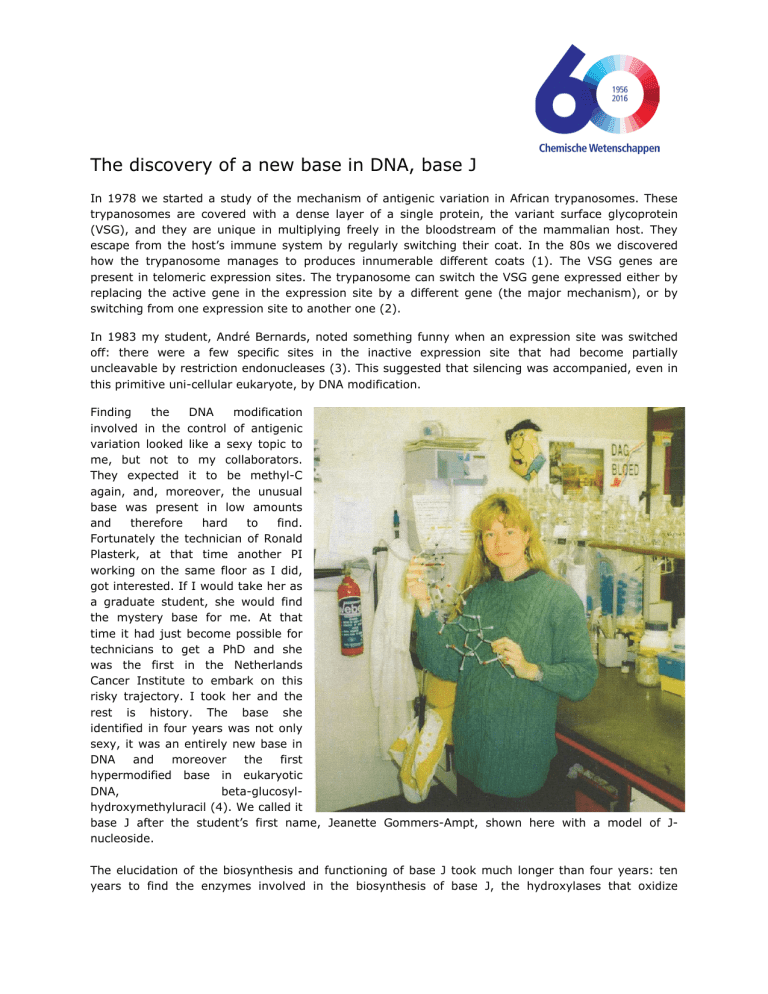
The discovery of a new base in DNA, base J
In 1978 we started a study of the mechanism of antigenic variation in African trypanosomes. These
trypanosomes are covered with a dense layer of a single protein, the variant surface glycoprotein
(VSG), and they are unique in multiplying freely in the bloodstream of the mammalian host. They
escape from the host’s immune system by regularly switching their coat. In the 80s we discovered
how the trypanosome manages to produces innumerable different coats (1). The VSG genes are
present in telomeric expression sites. The trypanosome can switch the VSG gene expressed either by
replacing the active gene in the expression site by a different gene (the major mechanism), or by
switching from one expression site to another one (2).
In 1983 my student, André Bernards, noted something funny when an expression site was switched
off: there were a few specific sites in the inactive expression site that had become partially
uncleavable by restriction endonucleases (3). This suggested that silencing was accompanied, even in
this primitive uni-cellular eukaryote, by DNA modification.
Finding
the
DNA
modification
involved in the control of antigenic
variation looked like a sexy topic to
me, but not to my collaborators.
They expected it to be methyl-C
again, and, moreover, the unusual
base was present in low amounts
and
therefore
hard
to
find.
Fortunately the technician of Ronald
Plasterk, at that time another PI
working on the same floor as I did,
got interested. If I would take her as
a graduate student, she would find
the mystery base for me. At that
time it had just become possible for
technicians to get a PhD and she
was the first in the Netherlands
Cancer Institute to embark on this
risky trajectory. I took her and the
rest is history. The base she
identified in four years was not only
sexy, it was an entirely new base in
DNA
and
moreover
the
first
hypermodified base in eukaryotic
DNA,
beta-glucosylhydroxymethyluracil (4). We called it
base J after the student’s first name, Jeanette Gommers-Ampt, shown here with a model of Jnucleoside.
The elucidation of the biosynthesis and functioning of base J took much longer than four years: ten
years to find the enzymes involved in the biosynthesis of base J, the hydroxylases that oxidize
selected T’s in DNA (5) and another ten years to discover a function of base J. In both cases the end
results were rewarding. The hydroxylases induced L. Aravind to look for analogous enzymes in
mammals and he found the TET enzymes, oxidizing methylC; and base J turned out to act as a
terminator of Pol II leading to spectacular readthrough transcription when we removed J (6).
Source: Piet Borst (NKI)
References
(1) Hoeijmakers J.H.J., Frasch A.C.C., Bernards A., Borst P., Cross G.A.M., 1980 Novel
expression-linked copies of the genes for variant surface antigens in trypanosomes, Nature,
284: 78-80.
(2) Bernards A., De Lange T., Michels P.A.M., Huisman M.J., Borst P., 1984 Two models of
activation of a single surface antigen gene of Trypanosoma brucei, Cell, 36: 163-170.
(3) Bernards A., Van Harten-Loosbroek N., Borst P., 1984 Modification of telomeric DNA in
Trypanosoma brucei, a role in antigenic variation?, Nucl. Acids Res., 12: 4153-4170.
(4) Gommers-Ampt J.H., Van Leeuwen F., De Beer A.L.J., Vliegenhart F.G., Dizdaroglu M.,
Kowalak J.A., Crain P.F., Borst P., 1993 β-D-glucosyl-hydroxymethyluracil: a novel modified
base present in the DNA of the parasitic protozoan Trypanosoma brucei. Cell,75: 1129-1136.
(5) Yu Z., Genest P.A., Ter Riet B. Sweeney K., Dipaulo C., Kieft R., Christodoulou E., Perrakis A.,
Simmons J., Hausinger R., Van Luenen H., Rigden D., Sabatini R., Borst P., 2007 The protein
that binds to DNA base J in trypanosomatids has features of a thymidine hydroxylase, Nucl.
Acids Res. 35: 2107-2115.
(6) Van Luenen H., Farris C., Jan S., Genest P.A., Tripathi P., Velds A., Kerkhoven R.M.,
Nieuwland M., Haydock A., Ramasamy G., Vainio S., Heidebrecht T., Perrakis A., Pagie L., Van
Steensel B., Myler P., Borst P., 2012 Glucosylated hydroxymethyluracil (DNA base J) prevents
transcriptional read-through in Leishmania, Cell, 150(5): 909-921.












